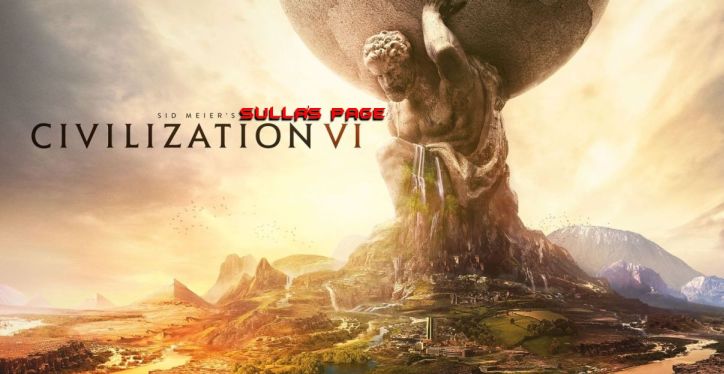

At the same time that I was catching a lucky break at Arretium, I had already amassed enough culture to reach Political Philosophy civic and open up the first governments. On Turn 36, no less! For those of you who haven't played Civ6 before, that is insanely early to reach the first governments. In a non-Roman game, the player often doesn't hit this point until roughly Turn 65. This was my post at the time explaining the different governments and policies available to choose between:
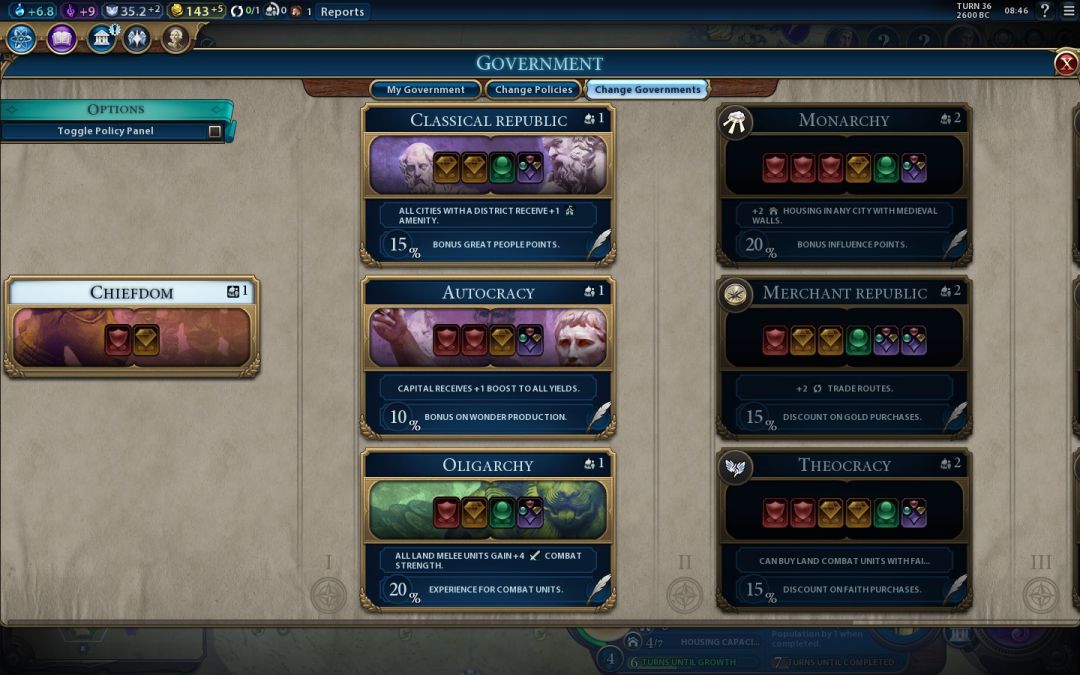
|
Sullla: Almost overshadowed this turn was the arrival of Political Philosophy civic and the first three governments. This is civic #6 for me on the tree, on the direct beeline that everyone pretty much always takes in Civ6. Teh has just picked up his fourth civic, and TheArchduke and Yuris both have three civics researched. So this is a significant edge for me, getting to open these up before the other competitors can do the same. Out of the three options here, my preference in Single Player games is usually for Classical Republic, since it offers the most possible Economic policy slots and has two other useful benefits in the Great Person point bonus and the amenities for cities with a district. Autocracy can also be really nice, since it ditches the fairly weak Diplomatic policy slot in favor of another Military slot, although it also trades an Economic slot for a Military slot which tends to be bad in Single Player. Here in Multiplayer those Military slots become a lot more useful, since you can't simply ignore the combat side of the game due to the feeble AI. The one government that rarely gets used is Oligarchy because all of the benefits relate to combat, and it's easy to win against the AI without those benefits. Against other humans though, the +4 combat strength for melee units is quite strong indeed, and even the experience bonus is no laughing matter, especially if combined with units that were built using a barracks (which grants +25% experience). In this game, I'm going to start with Classical Republic to get my economy off and running, then switch into Autocracy when I initiate my military buildup, and then finally switch into Oligarchy for an actual attack. At least, that's the plan for right now. 
Here are the policies that I picked in my new government. Urban Planning is always great in the early game and helps new cities out tremendously, Ilkum helps my new cities get their workers done faster, and Colonization stays while the capital works on its latest settler. When the settler finishes, I'll probably swap out Colonization for Agoge again in the Wildcard spot, or potentially the Great General policy that I'll have from researching more civics. A lot depends on how much military power the other players have half a dozen turns from now. The Diplomatic slot is the interesting one for the moment. I'm taking Diplomatic League over the normal Charismatic Leader, since I'm going to research Mysticism next for the free envoy it awards. When that finishes in 3 turns, I'll drop the envoy into Stockholm and get 2 envoys instead of the normal 1 envoy, then swap into Charismatic Leader to generate the next envoy faster. This way I only spend 3 turns running Diplomatic League, which of course I want to minimize time spent in. Some of the other policies here will be useful later on, especially Caravansaries and Conscription, but there's no need for either at the moment. |
I continued to stick with the maximum economic setup for civilization development. I'd been building a few more military units with the Agoge policy while researching Political Philosophy civic, and I now had 2 warriors and 2 slingers, enough units for the moment in this barbarian-free game. With no further units under development, this was the perfect time to go over to the infrastructure paradise setup detailed here. My capital was building a settler, my two new cities were working on builders, and all of them benefitted from Urban Planning. I've run this exact setup many times in Single Player games, and it's a good way to accerlerate the development of peaceful units - if not so great at defending against attack.
I also threw down the Encampment district at the capital to lock its cost in place. This was one spot where my extremely fast culture actually hurt me, as the district cost had already scaled up to roughly 120 production - ouch! Of course, without all that culture, I wouldn't have culturally acquired the tile in the second ring to place the Encampment down, so again I couldn't really complain here. I continued training the next settler in the capital for the moment, Roma pumping out a massive 18 production/turn for this stage of the game with the Colonization bonus.
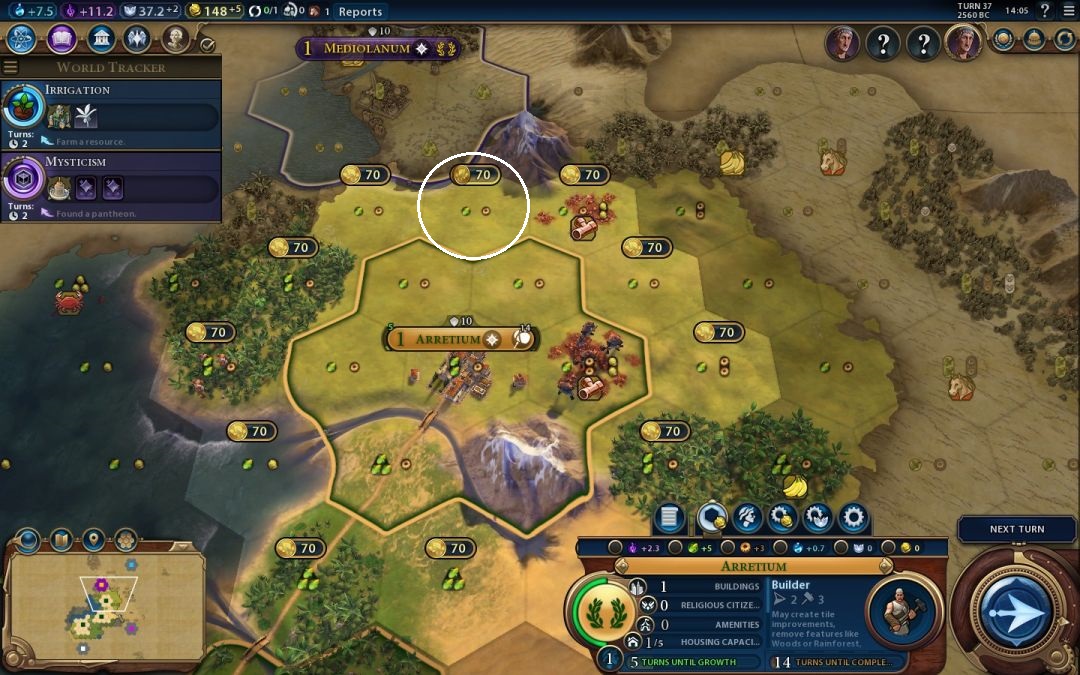
Up at Arretium, I went ahead and purchased the circled tile for 70 gold. Here was my rationale at the time: "I was thinking about this throughout my morning, and ultimately decided it was worth the gold. There are three interlocking motivations for spending this gold. The first is defensive; controlling that tile makes attacking me even more difficult, as I get additional vision into TheArchduke's territory and make unit movement more difficult for him. He can't enter my territory at all without declaring war or signing Open Borders (which I will not sign), and so controlling this tile makes movement more difficult for him. Second, I want to own this tile to secure control of the northern copper tile. That will be the first tile grabbed by my city when the borders expand, since it's the only resource tile in the second ring, and I don't want TheArchduke purchasing over to the tile to swipe it away. With the circled tile under my control, he would have to purchase the mountain tile first and only then could spend the even higher gold amount needed to grab the copper tile. I don't think he'll see that as a worthwhile gesture, whereas it might be worth it for him to grab the plains tile and then the copper.
If that was all, I wouldn't bother purchasing this tile for the 70 gold. However, the circled tile is also where I plan to build my Commercial district for this city down the road, and that tipped the scales for me. I want the Commercial district to be on a river for the +2 gold/turn bonus, and that only leaves three eligible tiles here. It can't go on the floodplains tile because districts can't be built on them; only Egypt can build on those tiles. I also can't build on the plains tile west of the city, the most obvious location, because I need to save that spot for the Roman Bath district later. The only other place the Bath could go would be on the southern copper tile, and that's way too good of a tile to waste. So it has to be one of the two river tiles in the north, and the one next to the copper tile is the more valuable one to control. This purchase will pay for itself 35 turns after the Commercial district is finished, for what that's worth. And if this purchase secures me the northern copper resource, well, that's another 2 gold/turn tile which I will be working the moment this city hits size 3. So this might be debatable if it means upgrading one fewer warrior into a legion later on, but I think there was enough in favor of the purchase to make it worthwhile."
Much to my surprise, however, TheArchduke went ahead and purchased the mountain tile in question, then the copper tile! 
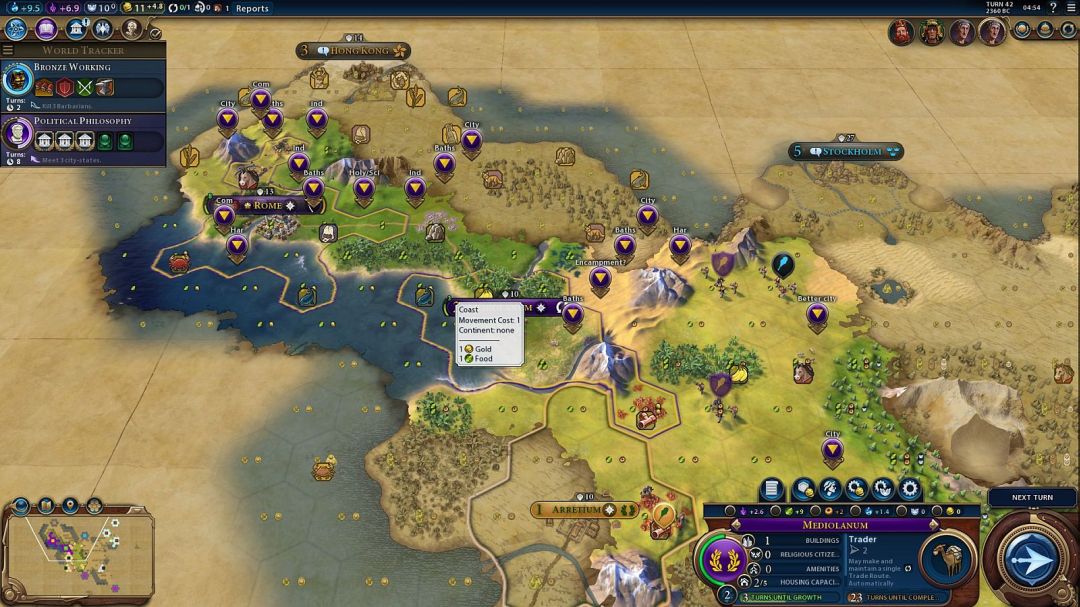
|
TheArchduke: I bought an overpriced copper to make sure and make a point to Sullla that I won't tolerate further encroachment and the big question is, do I dare to settle the middle. I do not think so, because I do not want to anger the Aztecs before I have legions. |
TheArchduke continued to throw me off balance with his unusual moves. I didn't expect anyone to spend a combined 170 gold to purchase a useless mountain tile and then the copper, but TheArchduke went ahead and did so to make a point. From my perspective, this was mostly confusing more than anything else. In restrospect, I overthought this situation as well: if I was going to purchase a tile, I should have just bought the copper tile! Heh. This would make things very tight later on for my planned warrior to legion upgrades, as I was out 70 gold for purchasing that tile, plus I lacked the 2 gold/turn that I expected to have from working the second copper. This was a definite misplay on my part.
My research into Mysticism civic completed on Turn 39. I wasn't interested in a religion or any of the buildings unlocked by the civic, but Mysticism awards an envoy upon discovery, and that was quite useful indeed:

That was the whole reason I went for the civic, since I didn't care about any of the policies it unlocked, and it leads only to more religious stuff at the bottom of the civics tree. With a free envoy to award, I went ahead and dumped it into Stockholm for the +2 science, and since I was running Diplomatic League policy, the first envoy counted as two envoys. Now I only needed one more to reach three and become the suzerain of Stockholm. Science increased from 8 beakers/turn to 10 beakers/turn, a major increase. I also took advantage of the free civics swap to replace Diplomatic League with Charismatic Leader policy. The new policy took me up to 5 envoy points/turn, and I was currently at 44 envoy points. I would land another envoy at 100 points, so in 12 more turns I could become the suzerain of Stockholm. I had nowhere else to put the envoys and Stockholm had a highly useful suzerain bonus, so that was the plan if nothing else came up. (This is another benefit of Rome's culture and reaching the early governments so quickly: faster access to envoys and greater control over the city states. As we would see in this game, the city states proved to be quite significant actors indeed.)
The next turn I saw this message pop up: an unmet player has been defeated! 
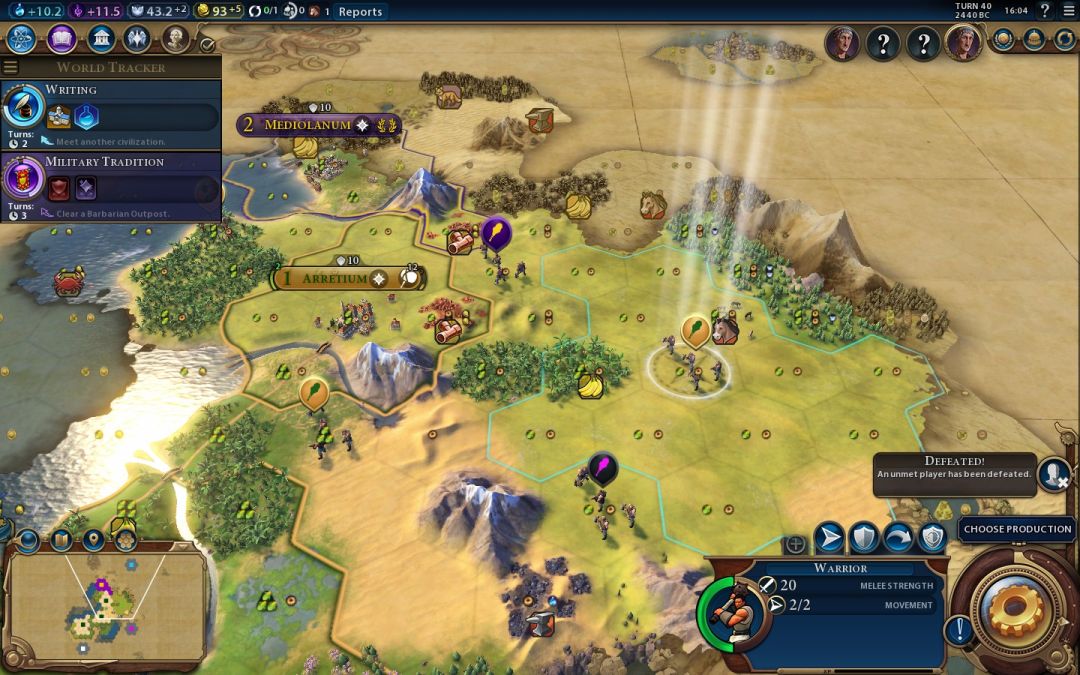
Now this didn't mean that one of the other players in the fog had been defeated; all four of the human players were alive and kicking. What it indicated was the conquest of one of the city states in the game, and the aggressor in this case was Yuris. He had built three Eagle Warriors and conquered the Commercial city state of Lisbon next to his capital:
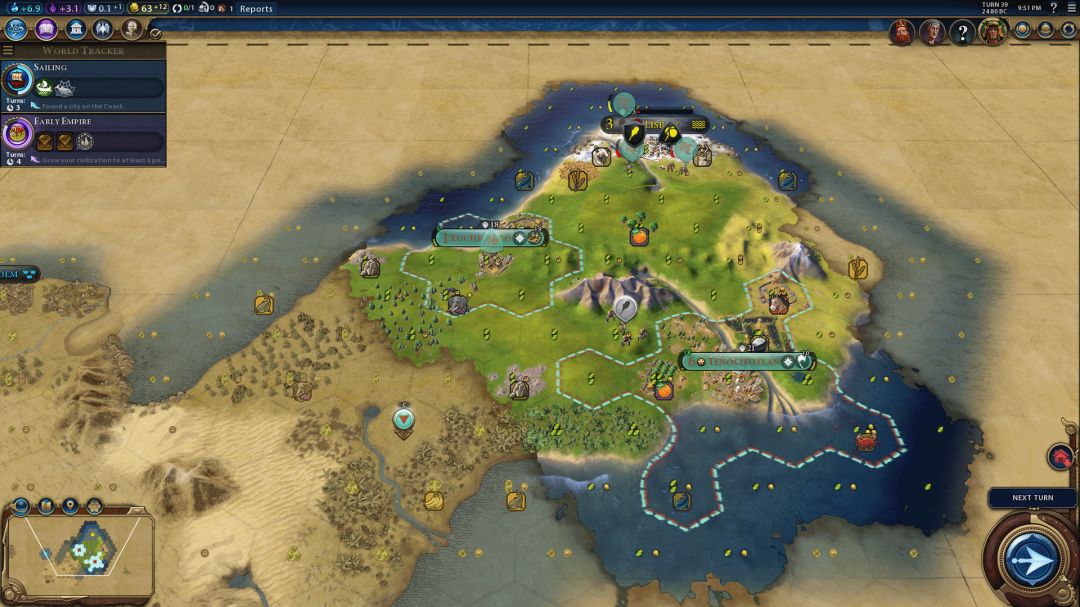
Yuris' city state capture took him up to three cities, and he also managed to use the Eagle Warrior unique ability to snag three (!) builders in the process. This was a sorely needed short in the arm for Yuris, and helped take a civ that was starting to fall the curve behind back into relevancy again. Yuris had chosen to settle his capital on the coast, and unfortunately this caused him to be lacking badly on production despite lots of food for growth. If you compare the beaker and culture rates at the top of that screenshot to the ones taken from my point of view, it should be clear that Yuris was lagging here. Picking up a "free" size 2 city (that did not scale up the cost of settlers) was a huge asset to his fledgling empire.
The downside was that Yuris would no longer be able to benefit from the substantial help provided by that city state: +4 gold/turn for the first envoy, and then another +4 gold/turn for every Commercial district once Yuris reached 3 envoys. He had actually picked up 2 envoys for free thanks to the first-to-meet bonus and an easy quest. In the long run, it might have been better to keep this city state around to pump up Yuris' Commercial districts later. The other big drawback was that Yuris was using the early game power of his Eagle Warriors here in the northern tundra, and not elsewhere terrorizing the other players. By the time that Yuris could heal his Eagle Warriors and then march them to another player's territory via the slow movement rules of Civ6, it might be too late to launch another attack. Overall then, was this move worth it? It was hard to say, and time would have to be the final judge.

Back at home, I connected my first luxury resource with a plantation on the same turn that the capital grew to size 5 and triggered the amenities penalty. Plantations themseves are a lousy tile improvement, adding half a point of housing and 1 gold/turn. (They eventually get +1 food at Scientific Theory and another +1 gold at Globalization, both much later in the game.) In a major distinction from Civ4, adding most improvements to a tile does *NOT* remove forest/jungle status. Forest tiles provide +1 production in Civ6, so I had the option of bulldozing the forest for an immediate production bonus. However, that would remove the forest for the rest of the game, and it would require another builder charge to do so. I did not think it would be worthwhile in this case.
Anyway, I was able to add the plantation without removing the forest, and so this tile went from 4/1 yield to 4/1/1 yield, picking up a single gold piece in the process. If you were been wondering why I mostly ignored plantations to date, this is the reason. They are not very useful in the early game compared to mines and farms. That said, I did need the happiness, and Ravenna would benefit from the housing when I also added a plantation on the bananas. For that matter, I needed the gold as well; I needed to save up another 500-600 gold in the next 40 turns for my planned unit upgrades. This was a good fit for what my cities needed right now. With the unhappiness penalty removed, my cities saw small increases to all of their various yields. Roma and Ravenna lost the unhappiness penalty, which Arretium gained the happiness bonus of +5% for being in positive amenities. When the interface eventually updated, I increased to 11.8 beakers/turn, 12.4 culture/turn, and 8.1 gold/turn. Ravenna now started a trader unit for the Currency boost, while the capital finished up its current settler.
On the next turn, my warrior crossed the eastern hills and contacted teh's German civ:
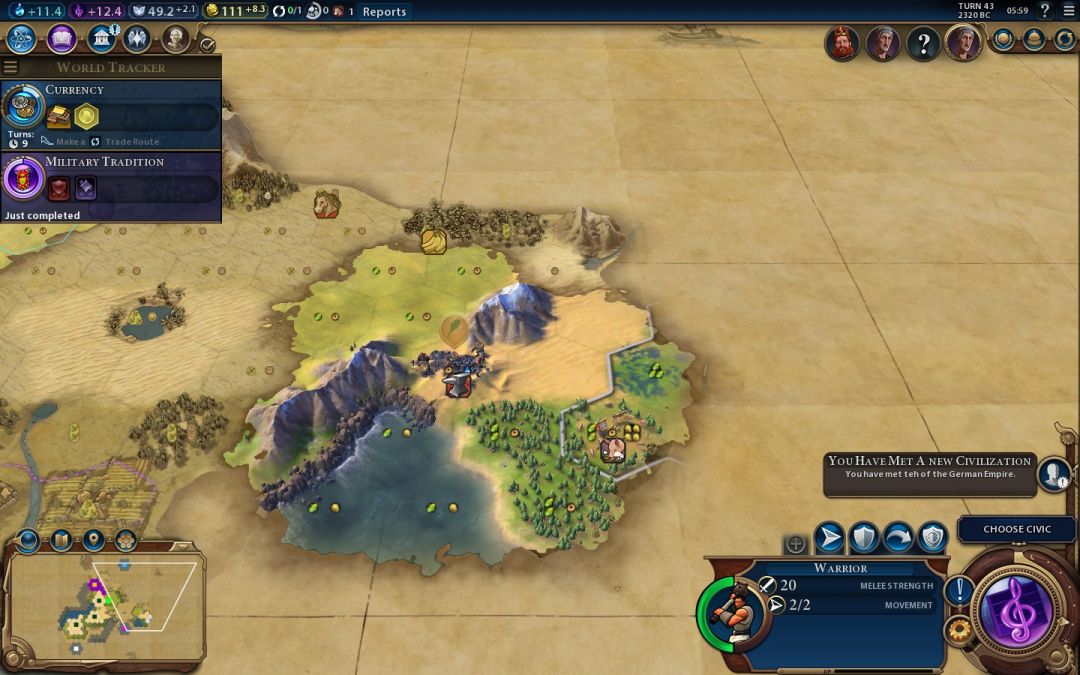
Teh's city of Cologne had to be located at the mirrored Ravenna site based on the borders that I could spot here. This prompted a post discussing some thoughts on teh's development:
|
Sullla: Now that I have formal contact with teh, I have additional information at my fingertips on the international world rankings screen. Teh has six techs researched, the same as me, and just completed his fifth civic research this turn. That means that he also finished the expensive State Workforce civic and will be pursuing Political Philosophy next. His beaker rate is 8.7/turn and his culture rate is 6.8/turn. You can see the comparison to my tallies at the top of the screenshot. Teh is doing quite well for himself in these categories; he's only a single population point behind me at the moment, 9 pop to my 10 pop, and the discrepancy in science comes almost entirely from my envoy at the Scientific city state. I have almost double his culture because, well, I'm Rome and I have the disgusting ability to get three free monuments. Like me, teh also has an envoy with a Cultural city state helping him out in this category. I can now see teh's power directly, and he has 50 military score. That's almost certainly two warriors and a scout, unless he's been fighting Yuris and has a damaged unit or something like that. I had him pegged at two warriors and a slinger earlier, and I'm happy to see the scout build instead. Scouts don't upgrade into anything useful until rangers a million techs away, and their 10 strength makes them virtually useless in combat. (One note of caution: their 3 movement does give them the chance to snipe builders/settlers if left unprotected though.) Still, I'd rather see a scout than a sliger that's a mere 30 gold away from becoming a powerful archer. Finally, in the mostly useless Religious category, I can now spot that both TheArchduke and teh have swapped out of God King policy and are now getting 0 faith/turn. I can't see what pantheon teh chose for himself, as it did not appear as a gossip item on the diplo screen like it did with TheArchduke, probably because I didn't have contact when he established his pantheon. 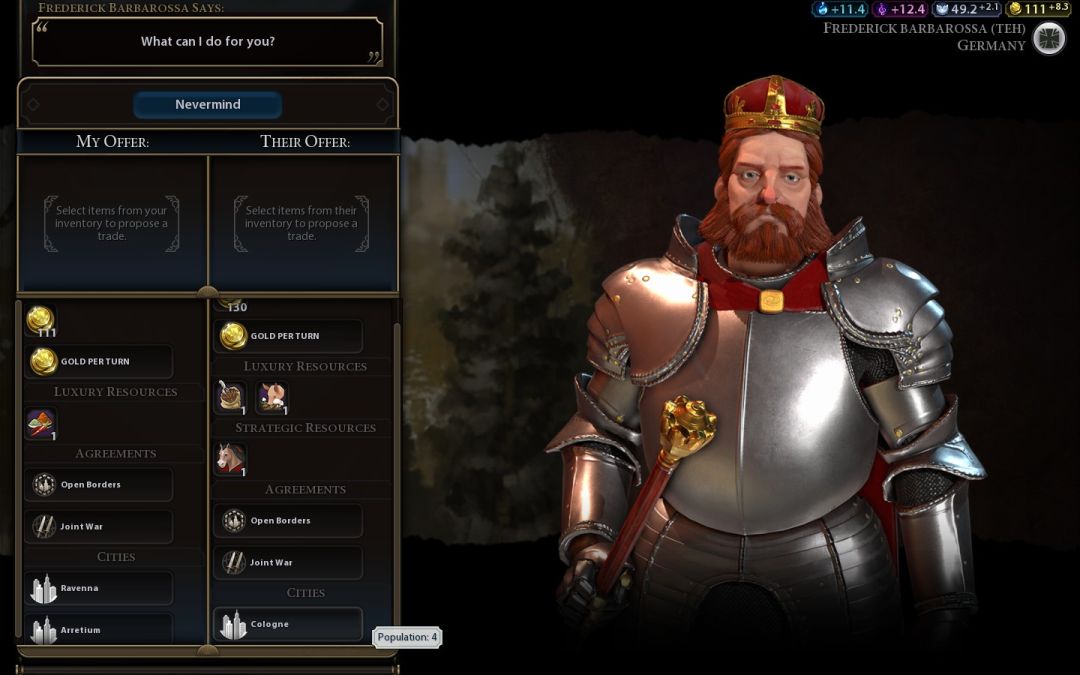
Here is the actual diplo screen with teh. He has two luxuries connected, the coffee at his capital along with the truffles at his second city. I can also see that the second city is named Cologne (I guess none of us are being that creative in this game on the names). Perhaps this is why teh hasn't shown up with a third city yet, because he went for a trader and an additional builder in his capital (?) I'm surprised that I haven't seen another settler appear in the population tracking from teh, although it's possible that he did produce one that was hidden by a pop increase, the way that TheArchduke did. It's been almost 20 turns since he founded his second city now. If he's still looking weak 25 turns from now, perhaps I'll choose teh instead of TheArchduke for an attack, although the logistics are easier to pull off with my northern neighbor. (Of course, TheArchduke doesn't need iron to build his legions, so Germany may be a better target than northern Rome regardless.) |
Teh had been strongly mirroring my play thus far, with a capital and second city in the identical location and the same mirrored opening sequence of builder into settler. He had diverged from me later on by building slightly more military and getting a builder out of his capital rather than an early second settler, but mostly we had been on nearly identical paths to date. In fact, teh was also tracking the scores of the other players and interpreting what they meant, while pondering over his own strategy for the upcoming turns:
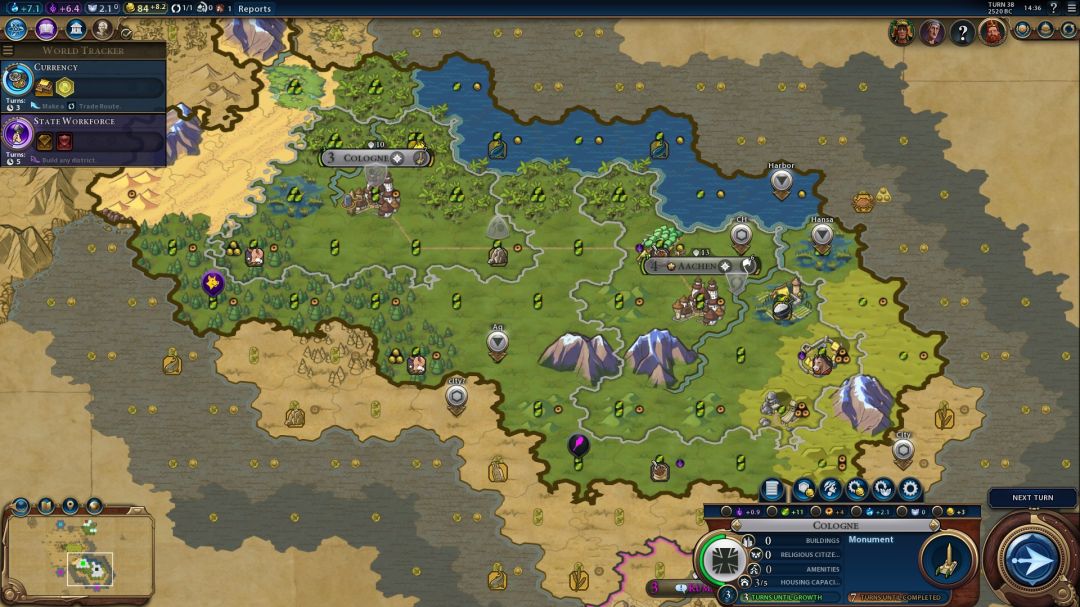
|
teh: I'm assembling my new report, but in the meantime, the first settler is going to head next to the copper in the center region (where I have already placed a pin - check my latest screenshot for turn 33). I don't see many military units there, so I might send the second settler even further into the center region (where the natural wonder is and where there are some horses - again, see the last screenshot). The hex south of the horses + bananas there (E-E of the natural wonder) would grab 2 horses (1 in the first ring, 1 in the second ring) and would have some grassland hills for extra production. I'd like to grab that spot. If not, I have a city location in my peninsula, in the southern section near the city state, but it's a worse spot that I'm reserving for a later settler. In terms of mid-term plans, I'd like to conquer Vilnius (the city state on the southern end of the center region) and possibly Stockholm (on the northern end of the center region). I have +7 strengh against city states, and if I can get some archers (by upgrading slingers) I think it would be easy to take them out. Right now, I have no envoys in either one, so it would not hurt me to conquer them outright. That would draw the attention of other civs in the game, though. I noticed that one city state is already eliminated (got a notification), so someone conquered a city state in their starting peninsula. I would do the same for Kumasi except it's giving me some nice culture at the moment, so maybe later. In terms of the opening turns, I would say I probably played them a bit more conservative than needed, as in, I could've easily skipped out the 2 slingers and gotten my 2nd settler out much quicker. Also, I should've explored the center region more quickly either with my starting warrior, or by getting a scout (like I saw Archduke do). Missing out on the free envoys for the 2 city states there put me slightly back. The biggest challenge for me is, if I decide to settle aggressively in the center, to have enough military to keep a hold of that rich region. Taking out city states in the middle would be a complimentary strategy to settling there, and like I said, with Germany's +7 extra strength against them, it should be doable with less military than other civs. It also takes out the benefits other civs get from having envoys there. The lands around Stockholm and Vilnius are much better than the lands around Kumasi (the city state in my peninsula), so I'm leaning towards attacking them instead of Kumasi. Also, I have an envoy in Kumasi providing me +2 culture which helped me tremendously in the initial stages, but that could easily be replaced by a monument at this point in the game, so I might take it out. The suzerain bonus is nice, but it's so far in future that it might be better to control that land directly than wait for 5 envoys to come. |
Teh's screenshots are always easy to distinguish because he played most of this game in Strategic Mode, which I also find charming even if I don't use it myself. Teh was also planning on putting his third city in the double river copper region, the mirrored area in the east where I had already established Arretium in the west. He was also thinking about trying to conquer the city states in the center (Stockholm and Vilnius), potentially using the very nice German +7 strength bonus against city state units. Both of us were increasingly focused on the central part of the map, which was going to be crucial to everyone's hopes of reaching a dominant position.
From my perspective, when I completed my third settler and finished researching Military Tradition civic, I made the following policy swap:

I dropped Colonization policy in favor of Strategos and its +2 Great General points/turn. This was not a policy that I wanted to be running too much of the time, as I continue to believe that it's a weaker option in comparison to the production-boosting policies. However, I did want to make sure that I snagged that first Great General as it was integral to my plans, and for the moment I essentially had a free policy slot because I didn't need to keep running Colonization while I wasn't building settlers. The only other strong option here right now would be Agoge for the military production bonus, and with me in first place in power at the time, I thought I could sneak through the next ten turns or so without needing it. I really did want to get the Encampment built at some point in the next 15-20 turns though, specifically so I didn't have to spend more time in Strategos policy than necessary. Right now, I was thinking that I could have the capital go builder into slinger (yes, without Agoge in place, sadly) and then work on the Encampment until my next civic finished, then pick up Colonization again to turn out a settler, and then probably go into Autocracy after that for more Military policies. This was still very much contingent on what the other players were doing, of course. The next few civics were not going to be boostable, and the policy swaps would have some considerable time between finishing. With the first Great General costing 60 Great Person points, I was roughly 25-30 turns away from recruiting Boudica.
My third settler continued to head slowly to the central part of the map, using the free Roman roads where available, otherwise passing through the wildnerness escorted by my military units. It was heading for this area:
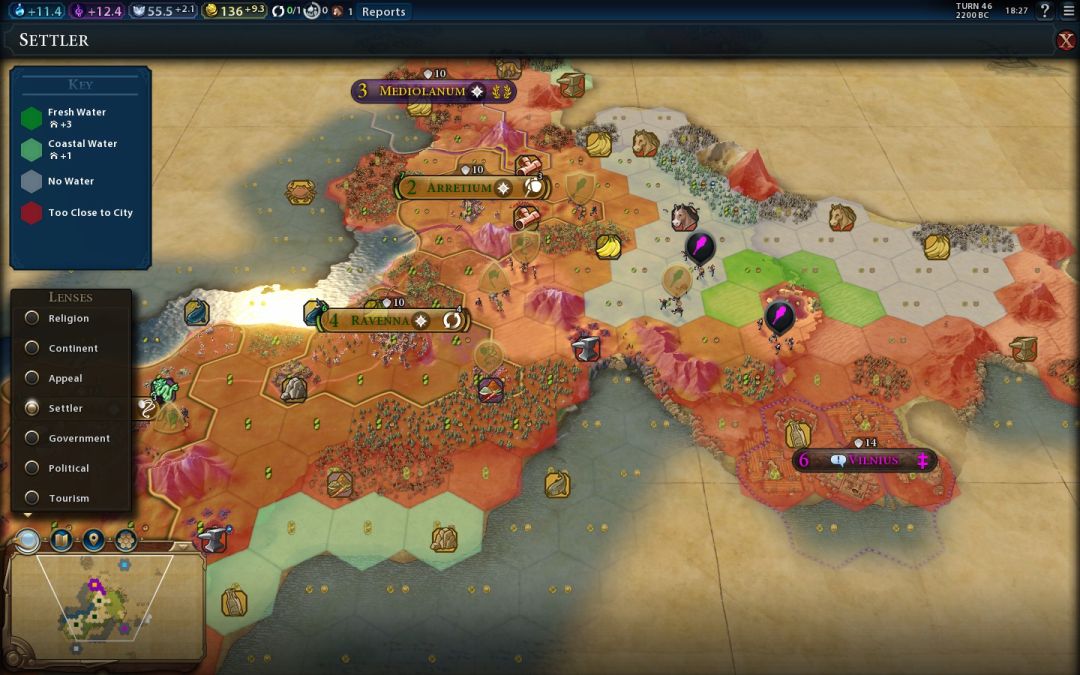
This was a wide angle shot of the map with the settling lens turned on. Note that most of the map was already a sea of red in my part of the world: no eligible city locations allowed. The oasis was a critical spot to control because it was the last source of freshwater available anywhere near my start. Once I claimed that spot and the southern coastal location by the cows and iron (the destination for settler #4), there would be almost nowhere else a city could go. The inland locations that lacked fresh water were almost useless, since they hit the housing penalty at size 1! Only with an aqueduct (or better yet a Bath) could they become viable.
The spot northeast of the oasis was particularly useful to claim, and it was where this settler was heading. That spot would grab the easternmost of the two horses on the first border expansion, and afterwards there would be almost no way to claim the western horses location because the city will lock out any other cities within 4 tiles distance. There would be exactly one spot remaining for another city: the tile northeast of the iron resource, and I did plan to put a city there later in the game. It was next to a mountain and could therefore build a Bath district, which immediately made that spot viable. With all of the desert tiles nearby, it could even be a potential Petra location - it wasn't like there was going to be much competition for Petra on this map with so little desert.
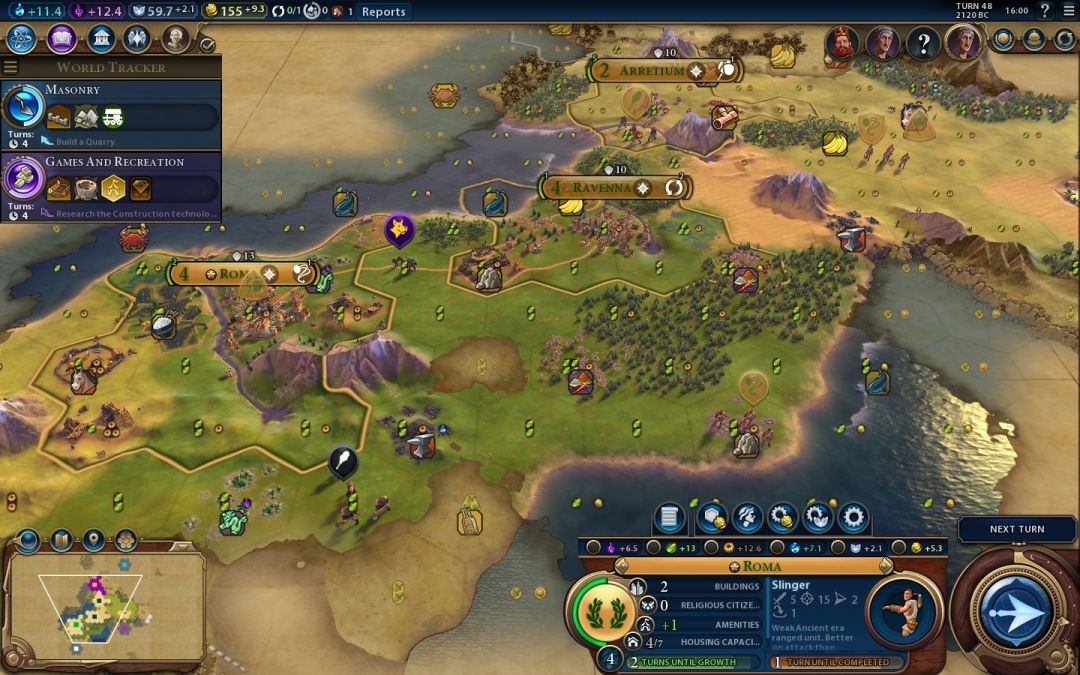
TheArchduke was also moving his scout around deep in my territory at this point, and I was actually trying to corner it and kill it with my units. However, I was never quite able to pin this thing down with its 3 movement, and eventually it managed to slip back out via that small area to the east of Ravenna. In retrospect, this probably worked out for the best: I was very much in builder mode at this point in time, and a war with TheArchduke could have thrown me off that path at an awkward time. It wasn't worth prompting a war just to whack this one weak unit.
As I moved my own settler to the middle of the map, it was joined in the north by a city from the other Roman player:

TheArchduke's settler found its destination at this city of Arpinum. I thought the location was very odd; since the northern half of this map was mirrored like the southern half, Arpinum was located one tile away from the oasis. Try looking at the screenshots above; the Arpinum location was the equivalent of being on the tile two northwest of the southern oasis. I didn't know why TheArchduke picked that tile; perhaps Yuris had a city nearby that excluded him from the oasis? But no, if Yuris had a city on the northern oasis, then the Arpinum location wouldn't be valid either. This didn't make any sense to me - why not move one tile further east and settle on fresh water?
Keep in mind that in Civ6 cities planted inland with no fresh water hit the housing penalty at size 1! That's -50% growth from the turn they are founded. Then even if they do manage to grow to size 2, they get hit with an even more severe -75% growth penalty at size 2. Yikes.  TheArchduke could potentially cash-rush a granary there to help Arpinum, except wait, no, he just spent almost 200 gold buying tiles for Mediolanum and had all of 50 gold in the bank right now. Granaries cost 240 gold so that wasn't happening, at least not any time soon. Arpinum did have good tile yields but it was going to be stuck at a runt size for ages on end. (I wanted to include TheArchduke's rationale for picking this location, but he didn't post about this in his thread. I believe he chose the Arpinum location because it had horses in the first ring.)
TheArchduke could potentially cash-rush a granary there to help Arpinum, except wait, no, he just spent almost 200 gold buying tiles for Mediolanum and had all of 50 gold in the bank right now. Granaries cost 240 gold so that wasn't happening, at least not any time soon. Arpinum did have good tile yields but it was going to be stuck at a runt size for ages on end. (I wanted to include TheArchduke's rationale for picking this location, but he didn't post about this in his thread. I believe he chose the Arpinum location because it had horses in the first ring.)
At virtually the same time, teh settled his own third city in the center of the map, at the identical spot as Arretium over in the east:

|
teh: Mainz grabs the copper and a floodplain in the first ring, with another of each in the second ring. I start working the floodplains to get a quick growth (5 turns) to size 2, and start building a slinger here (12 turns - but it will speed up once Mainz grows to size 2 by working the copper). |
Hey teh, stop copying all my actions! It's almost like these were good city locations or something.  Given a map that mirrored itself in most of the terrain, it's not a surprise that we were choosing to make so many of the same moves. Teh was roughly 10 turns behind my expansion pace, as he planted his third city at almost the same time that I was establishing my fourth city. He had more military to compensate, and much of this advantage was due to my civ choice of Rome, which leans towards the early game in a lot of ways. One thing I had to disagree with was the slinger build for Mainz; military is usually better produced in established cities. New cities need to get their basic infrastructure in place first, since that can't be supplied by another city. I was having my new cities open builder-first to improve their local tiles, since I didn't need monuments or granaries, freeing up the capital to work on pushing out more settlers.
Given a map that mirrored itself in most of the terrain, it's not a surprise that we were choosing to make so many of the same moves. Teh was roughly 10 turns behind my expansion pace, as he planted his third city at almost the same time that I was establishing my fourth city. He had more military to compensate, and much of this advantage was due to my civ choice of Rome, which leans towards the early game in a lot of ways. One thing I had to disagree with was the slinger build for Mainz; military is usually better produced in established cities. New cities need to get their basic infrastructure in place first, since that can't be supplied by another city. I was having my new cities open builder-first to improve their local tiles, since I didn't need monuments or granaries, freeing up the capital to work on pushing out more settlers.
Speaking of settlers, I matched teh by establishing my fourth city next to the southern oasis on the round date of Turn 50:

|
Sullla: I founded my fourth city by the oasis, just as planned from the beginning of the game. So far, so good. Interestingly enough, not one but two of teh's units appeared this turn: a warrior in the west by TheArchduke's territory and a slinger over in the east. That must mean that my unit tracking was incorrect: teh doesn't have 2 warriors and 1 scout, he has 1 warrior and 2 slingers. Interesting; he has only built two slingers the whole game. Also of interest: teh has settled his third city, and it's just visible peeking out from the fog off to the east. In fact, because this map is mirrored, I can tell that he went for the identical location as my Arretium off to the west. We have the exact same three city sites thus far. I also finished a trader in Ravenna this turn and shifted its destination over to the new city. I want to get a trade route between Arretium and Aquileia for movement purposes, and the new city can use the +1 food / +1 production more than the older city. It even speeds up growth to size 2 by one turn, dropping it from 5 turns to 4 turns. Of course, the trade route will also boost Currency tech and allow me to finish it next turn after a delay of several turns. Now for the Turn 50 comparison: Score Here's how that score is broken down: Cities/Pop The map is mostly full at this point, which means that a lot of the pop growth is going to have to be upwards from here, not outwards. Techs/Beakers Per Turn Civics/Culture Per Turn I have the most beakers/turn and culture/turn by good margins. Poor Yuris in particular has weak culture since he's not Rome and didn't start near a Cultural city state. He may have built a monument by now, I can't tell since I haven't met him yet. I'm still officially down in techs researched, but I will be able to complete 3 techs in the next 5 turns and that should sort that out nicely. Military Overall, I'm pretty happy with how things stand. I think I'm in the lead or close to it in the major categories, and so far my big picture plan for the game hasn't been throw off yet. I hope the next 50 turns can go as smoothly. |
All things looked good for the moment. Things were still going as I had planned before the game started, and I seemed to be in a healthy position in the international Demographics. When Games and Recreation civic finished on the next turn, I revolted back into Colonization policy to start my fourth settler in the capital, and dropped an envoy I had just earned into Stockholm. This made me the suzerain of the city state:
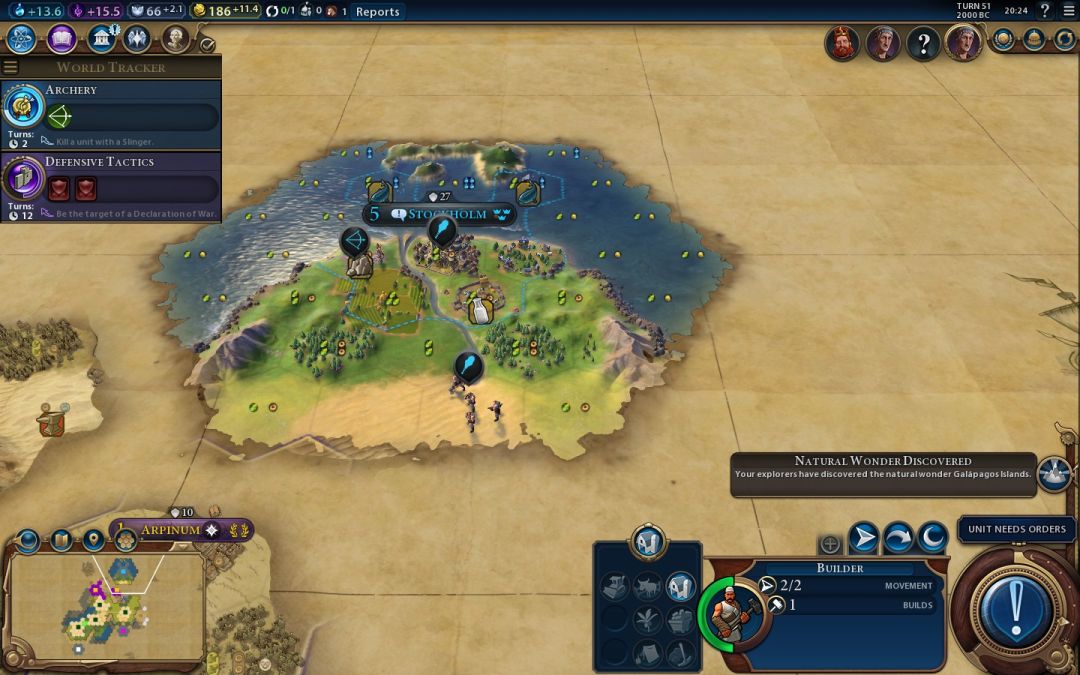
This meant that I picked up the "3 envoy" bonus with Stockholm: +2 science per Campus district. Of course, I had no Campus districts at the moment, heh. I also landed the suzerain bonus: +1 Great Person Point per district, which is one of the better ones in the game. It's like an even better version of the Divine Spark pantheon. Finally, I also obtained visibility of the city state, and it would follow me into war and peace. I could even pay the city state to take control of its units for 30 turns, which could be quite useful in a pinch. The opportunity cost for me was also very low, since I didn't really have anything else to do with that envoy anyway. Might as well take advantage of the vision and the suzerain bonus while I can, and I would figure out what to do if someone tried to attack Stockholm. At the very least, if Yuris or someone else tried to attack Stockholm, they would declare war on me as well and trigger the boost for Defensive Tactics civic. Given that Yuris had already conquered the city state of Lisbon, I was concerned that he would take his Eagle Warriors and send them after Stockholm for another conquest.
As it turned out, Aztec Eagle Warriors were indeed prowling about the center of the map, and they made contact with me on Turn 52:

Those 28 strength units were scary, especially the one that already had a promotion. The promotion was most likely Battlecry, which grants melee units +7 strength against other melee and ranged units, and 35 effective strength would do horrible things to my warriors and slingers. In fact, now that I had 3 total slingers built and Currency tech completed, I decided to finish off my research in Archery tech (which I'd been holding 1 turn away from completion) to open up the path towards Apprenticeship tech. I was done building slingers and I wanted to have the ability to upgrade them to archers if I would come under attack. Of course, I didn't actually WANT to upgrade my slingers into archers, because slingers cost no maintenance while archers cost 1 gold/turn in upkeep. Part of my plan was to build warriors and slingers since they are both free to maintain, then only turn them into legions and archers when I was actually ready for combat. That said, I needed something if those Eagle Warriors came calling, so I did want Archery tech in my back pocket just in case someone tried to come after me.
Fortunately for me, I was geographically the most distant player from Yuris in this game. He was thinking about a potential attack, but not against me:
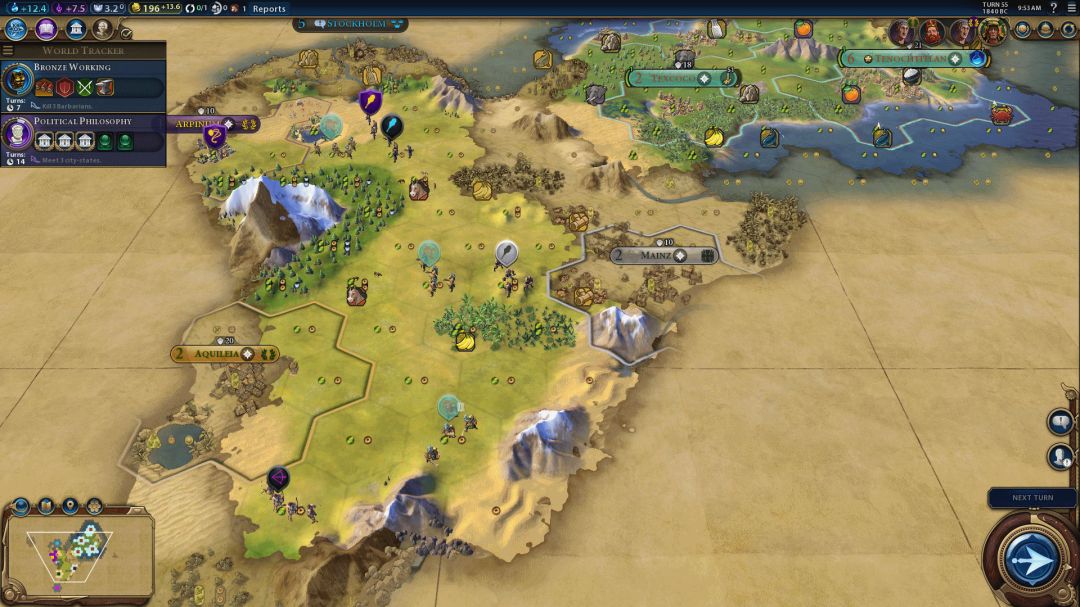
|
Yuris: I probably will be attacking teh. The reason is, he seems to have invested in Slingers (I saw another one in addition to the one in the screenshot above). And Slingers suck. Plus, his city is closest to my empire and will be easiest to integrate. Attack will likely happen in the next 3-5 turns. Unless teh adds more units. He currently has the Warrior (pictured) and 2 Slingers near the city. Pretty sure 3 Jags beat that. |
If Yuris had thrown all three of these Eagle Warriors against Mainz immediately, then teh might have been in real trouble. Mainz only had a defensive strength of 10, and it would have been crushed in short order. German slingers similarly would have been almost helpless against Eagle Warriors. Or Yuris could have sent his units against TheArchduke's city of Arpinum, which was also lightly guarded, or he could have chosen to go after Stockholm. However, Yuris split up his units for scouting purposes, and while that did reveal more territory, it also prevented him from striking anywhere in force. Three Eagle Warriors were a terror when supporting one another, but in isolation they were much less frightening.
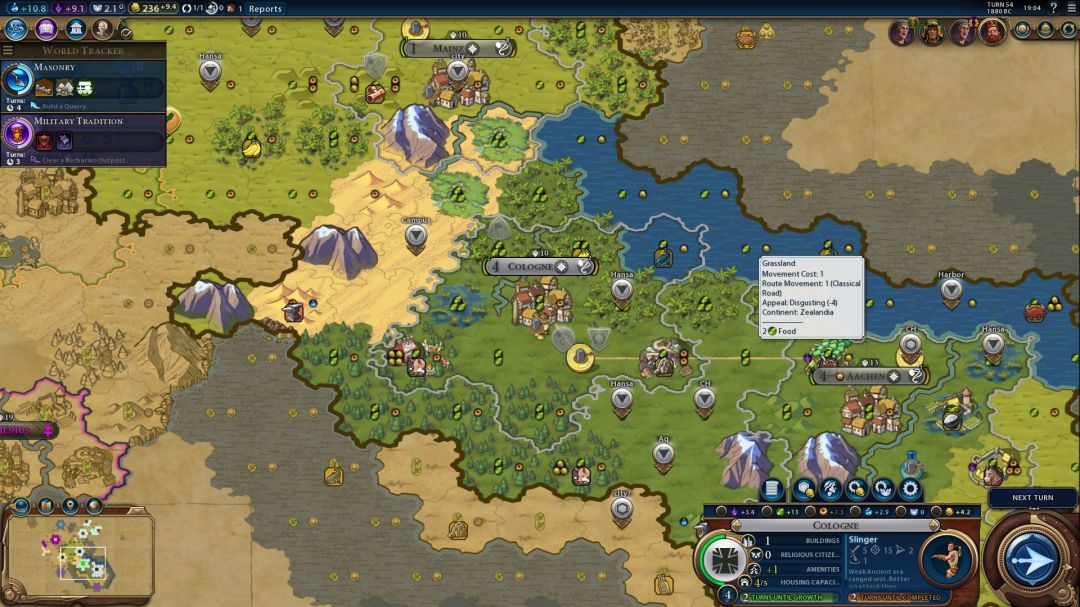
Teh had spotted those Eagle Warriors prowling around and immediately began a crash course of slinger builds, with the intention to finish Archery tech shortly thereafter and then upgrade them to archers. He was hoping to have 5 archers on hand in the next half dozen turns. Teh was also planning to reach further out to the center of the map with another settler, and so the key question was whether he could deploy these units in time to stave off a potential Aztec attack.
Of course, at the time I was unaware of much of this, happily building up my own civ since the threat from Yuris was minimal in my southwest corner. My cities were working on builders and the first Commercial districts, even as I slowly continued to progress towards the first Great General. When teh reached the first governments, he also picked Classical Republic and began running the Inspiration policy (+2 Great Scientist points/turn), which would eventually land him the first Great Scientist sometime down the road. I was still researching towards Apprenticeship tech via Horseback Riding for the moment, with a pit stop in Masonry tech to open up city walls and battering rams. Arretium was developing well:

Now this was quite nice for a size 3 city.  8.5 production/turn already and more to come later on with Apprenticeship tech and more hill mines. I was hoping that an upcoming border expansion would grab the other floodplains tile, which would be amazing. Another 4/1 tile (with a farm) would be great to let this city grow and solve its only real issue of having low food. When I finished Masonry tech, I swapped Arretium over to a battering ram. These are a type of support unit that let melee units do full damage when attacking a city with walls; without the battering ram, melee units do 15% of normal damage. Ouch! Needless to say, it's a good idea to bring one or two of them along when planning an attack. Basically, whatever the actual defenses of a city might be, if you bring some battering rams along it will fall quickly.
8.5 production/turn already and more to come later on with Apprenticeship tech and more hill mines. I was hoping that an upcoming border expansion would grab the other floodplains tile, which would be amazing. Another 4/1 tile (with a farm) would be great to let this city grow and solve its only real issue of having low food. When I finished Masonry tech, I swapped Arretium over to a battering ram. These are a type of support unit that let melee units do full damage when attacking a city with walls; without the battering ram, melee units do 15% of normal damage. Ouch! Needless to say, it's a good idea to bring one or two of them along when planning an attack. Basically, whatever the actual defenses of a city might be, if you bring some battering rams along it will fall quickly.
While I was still in development mode, teh was staking his claim to another part of the central map:
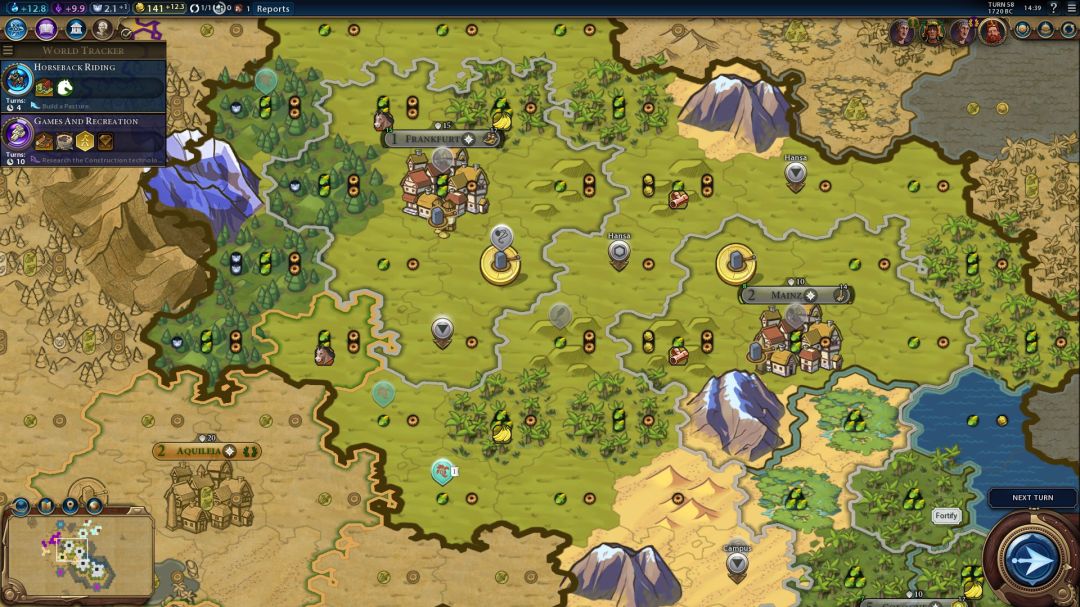
|
teh: The horses city is settled - Frankfurt is the name. I buy the tile SW-SE (2 tiles south of the city center) to be able to put down a Hansa there later. Since growth is at 50% before I improve the housing here, the city works the forested grassland hills to the west for the extra production over the bananas (and the extra faith over the horses). I start working on a granary here (17 turns, but it will speed once eventually once I have the horse pastured and start working it for 3 production). This city is weak right now as we discussed above with the lack of housing, but it has pretty good production tiles in the first 2 rings so it will be a good production place (certainly much better than Cologne with its lack of hills) once developed. I also placed down the commercial hub to lock its cost. Recall that Mainz's Hansa will go in between the two commercial hubs for a nice 6 production bonus, and Frankfurt's Hansa will be at 4 production eventually. You can see the archer in Frankfurt and the slinger next to it defending the city. I have a warrior between Frankfurt and Mainz, and a slinger defends Mainz. There's a slinger to the south (where the campus pin is located) and another archer just outside the screenshot. |
From my perspective, the city settlement looked like this:
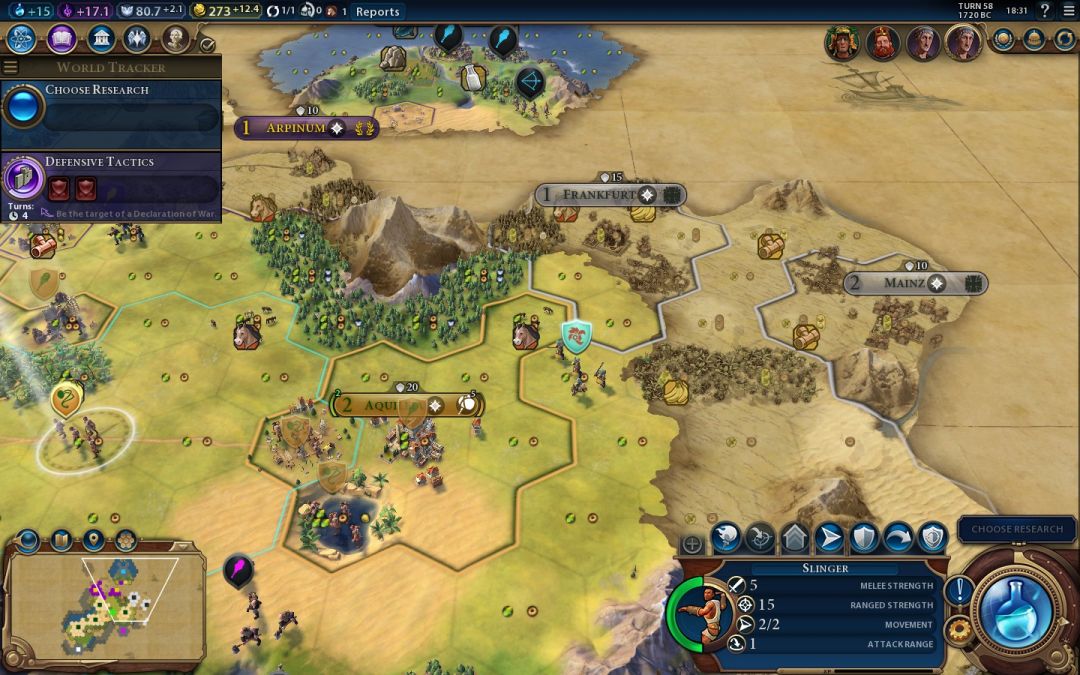
This was another city location that didn't have any fresh water available, and I was skeptical about its usefulness. As I noted at the time, Frankfurt's placement had a couple of significant strategic results. For starters, it ensured that teh would also be able to reach 6 cities eventually, with another location available in his starting peninsula plus his starting city state to capture. Yuris now looked like he had no opportunity to expand beyond his current 4 cities, and that was going to be a problem down the road. Second, I was now completely shielded from Yuris by teh's territory. If Yuris realized that he was running out of space and wanted to go after someone, it figured that I wouldn't be the target. And third, movement through the center of the map was mostly blocked now. No one was signing Open Borders with one another, and cultural borders blocked much of the map's center at this point.
Yuris' Eagle Warriors were also split up by this city placement, with two of them stuck on the south side of the Frankfurt/Mainz combo and the third one located to the north. Yuris wanted to launch an attack against those cities, but teh discovered Archery tech and began upgrading those slingers into archers at a cost of 30 gold apiece. This appeared to stave off an invasion in the nick of time:
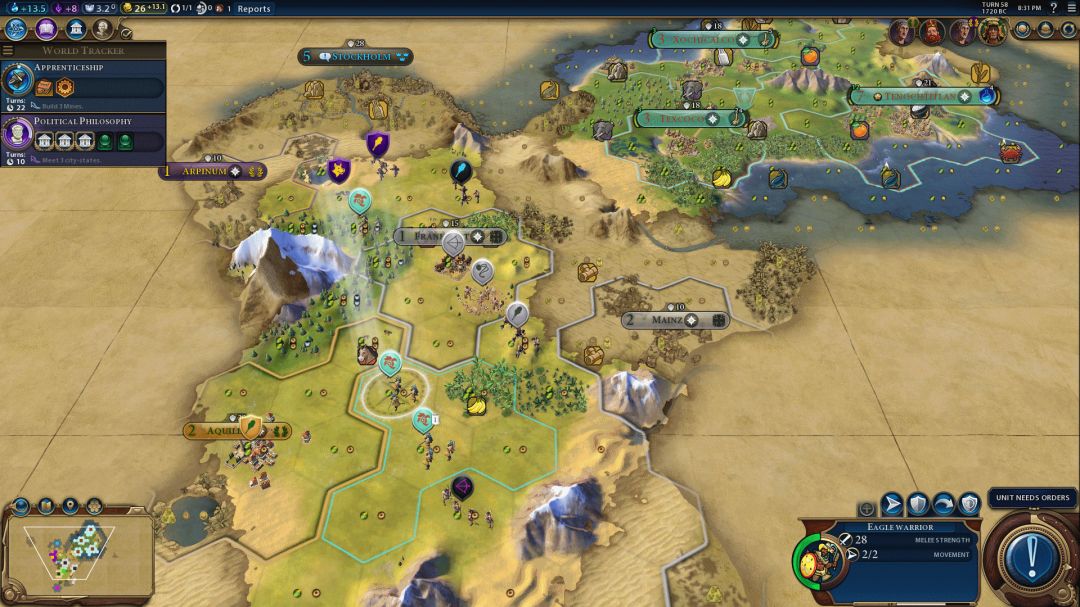
|
Yuris: Someone's doing crazy things.. and I can't punish him this turn. Disappointing. That's one aggressive plant though. I suspect it isn't just me who wants to punish it. teh upgraded his Slingers to Archers. And Archers have a very important distinction from Slingers: they don't suck. They in fact rule. Time to build some Archers of my own.... I want to punish that city so bad.... and geographically his cities would still be easiest to integrate. Just need to prepare properly now. 
Well, as it turns out, teh was within his right to make an aggressive plan. He has a lot more military than I thought (and a lot more than me). |
As it turned out, Yuris would decide not to launch an attack on teh, walking his units home via that narrow strip of territory between Mainz and Frankfurt. Teh's cities would not be tested by this potential threat - the archers had appeared just in time to deter the Aztecs. This was probably the correct decision too, as Yuris had no other units in this region and no reinforcements on the way. If you look at the top of that screenshot, all of the Aztec cities were in the process of building districts or infrastructure. Initiating a war here would have been a poor choice, as teh would have the defender's advantage plus much shorter lines of reinforcement. If Yuris had been serious about attacking, he should have brought more units than just these three Eagle Warriors into the center of the map. Yuris had been crippled by low production from the earliest stages of the game, and this was very apparent in this standoff.
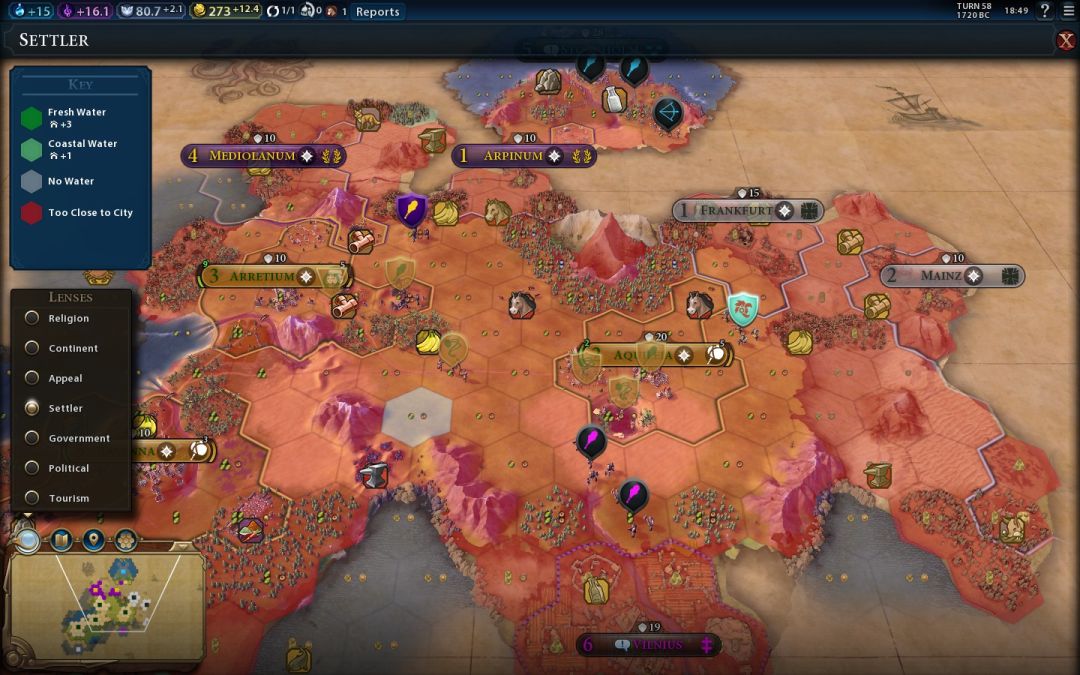
More importantly, the center of the map was now effectively full of cities, and there were no more opportunities for the Aztecs to expand. Yuris was going to need to get some more land somewhere to be a competitor in this game, and his options were slim indeed at this point. Look at that screenshot: that was a lot of red tiles on the map.  With the available land dwindling, it was only a matter of time before someone decided to initiate the first conflict. My war preparations were beginning to ripen, and with the first Great General of the game due in a dozen turns, I was going to have to decide whether to attack, and if so, who would be the target. This was my ultimate decision:
With the available land dwindling, it was only a matter of time before someone decided to initiate the first conflict. My war preparations were beginning to ripen, and with the first Great General of the game due in a dozen turns, I was going to have to decide whether to attack, and if so, who would be the target. This was my ultimate decision:
"I'll also mention that I've more or less decided that if I attack someone, it will be TheArchduke. Teh is simply playing too well; he upgraded another slinger to archer this turn, and I don't fancy invading him. (He's also swapped from Agoge to Conscription policy to avoid paying maintenance on those archers, in another smart move.) What's the most basic rule we've established from Civ4 Multiplayer games? Find the weak neighbor and take them over. TheArchduke looks like the weak neighbor by a growing margin. The fact that it's tactically much easier to invade him is simply a bonus. I'm going to ponder over the merits of trying to time an earlier attack today and see what I can come up with. It's a bit risky but the payoff could be game-winning."
Thus the plan was to go after the other Rome, and see if I could manage a successful strike against TheArchduke. Next up would be making the preparations and seeing if I could successfully execute a very audacious plan.



